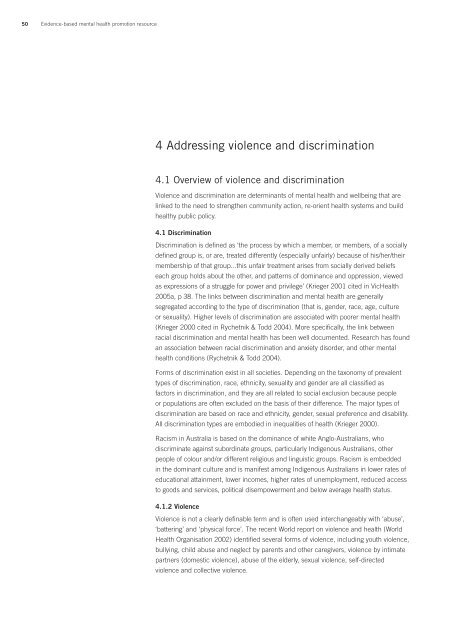Evidence-based mental health promotion resource - health.vic.gov.au
Evidence-based mental health promotion resource - health.vic.gov.au
Evidence-based mental health promotion resource - health.vic.gov.au
Create successful ePaper yourself
Turn your PDF publications into a flip-book with our unique Google optimized e-Paper software.
50 <strong>Evidence</strong>-<strong>based</strong> <strong>mental</strong> <strong>health</strong> <strong>promotion</strong> <strong>resource</strong>4 Addressing violence and discrimination4.1 Overview of violence and discriminationViolence and discrimination are determinants of <strong>mental</strong> <strong>health</strong> and wellbeing that arelinked to the need to strengthen community action, re-orient <strong>health</strong> systems and build<strong>health</strong>y public policy.4.1 DiscriminationDiscrimination is defined as ‘the process by which a member, or members, of a sociallydefined group is, or are, treated differently (especially unfairly) bec<strong>au</strong>se of his/her/theirmembership of that group...this unfair treatment arises from socially derived beliefseach group holds about the other, and patterns of dominance and oppression, viewedas expressions of a struggle for power and privilege’ (Krieger 2001 cited in VicHealth2005a, p 38. The links between discrimination and <strong>mental</strong> <strong>health</strong> are generallysegregated according to the type of discrimination (that is, gender, race, age, cultureor sexuality). Higher levels of discrimination are associated with poorer <strong>mental</strong> <strong>health</strong>(Krieger 2000 cited in Rychetnik & Todd 2004). More specifically, the link betweenracial discrimination and <strong>mental</strong> <strong>health</strong> has been well documented. Research has foundan association between racial discrimination and anxiety disorder, and other <strong>mental</strong><strong>health</strong> conditions (Rychetnik & Todd 2004).Forms of discrimination exist in all societies. Depending on the taxonomy of prevalenttypes of discrimination, race, ethnicity, sexuality and gender are all classified asfactors in discrimination, and they are all related to social exclusion bec<strong>au</strong>se peopleor populations are often excluded on the basis of their difference. The major types ofdiscrimination are <strong>based</strong> on race and ethnicity, gender, sexual preference and disability.All discrimination types are embodied in inequalities of <strong>health</strong> (Krieger 2000).Racism in Australia is <strong>based</strong> on the dominance of white Anglo-Australians, whodiscriminate against subordinate groups, particularly Indigenous Australians, otherpeople of colour and/or different religious and linguistic groups. Racism is embeddedin the dominant culture and is manifest among Indigenous Australians in lower rates ofeducational attainment, lower incomes, higher rates of unemployment, reduced accessto goods and ser<strong>vic</strong>es, political disempowerment and below average <strong>health</strong> status.4.1.2 ViolenceViolence is not a clearly definable term and is often used interchangeably with ‘abuse’,‘battering’ and ‘physical force’. The recent World report on violence and <strong>health</strong> (WorldHealth Organisation 2002) identified several forms of violence, including youth violence,bullying, child abuse and neglect by parents and other caregivers, violence by intimatepartners (domestic violence), abuse of the elderly, sexual violence, self-directedviolence and collective violence.



